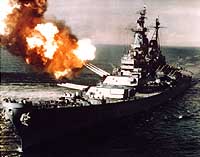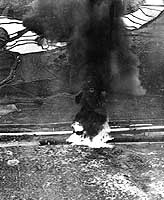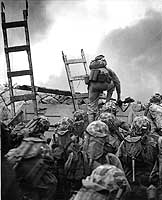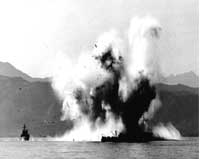
On 25 June 1950, the young Cold War suddenly turned hot, bloody and expensive. Within a few days, North Korea's invasion of South Korea brought about a United Nations' "police action" against the aggressors. That immediately produced heavy military and naval involvement by the United States. While there were no illusions that the task would be easy, nobody expected that this violent conflict would continue for more than three years.
Throughout the summer of 1950, the U.S. and the other involved United Nations' states scrambled to contain North Korea's fast-moving army, assemble the forces necessary to defeat it and simultaneously begin to respond to what was seen as a global military challenge from the Communist world.
Though America's Armed Forces had suffered from several years' of punishing fiscal constraints, the end of World War II just five years earlier had left a vast potential for recovery. U.S. materiel reserves held large quantities of relatively modern ships, aircraft, military equipment and production capacity that could be reactivated in a fraction of the time necessary to build them anew. More importantly, the organized Reserve forces included tens of thousands of trained people, whose World War II experiences remained reasonably fresh and relevant.
In mid-September 1950 a daring amphibous invasion at Inchon fractured the North Korean war machine. In the following two months UN armies pushed swiftly through North Korea. However, with victory seemingly in sight, China intervened openly, and the Soviet Union not-so-openly, on the side of their defeated fellow Communist neighbor. The UN was thrown back midway into South Korea. Early in the new year, the Chinese army was in turn contained and forced to retreat.
By the middle of 1951, the front lines had stabilized near where the war started twelve months earlier. Negotiations began amid hopes that an early truce could be arranged. But this took two more frustrating years, during which the contending forces fought on, with the U.S. Navy providing extensive air and gunfire support, a constant amphibious threat, relentless minesweeping and a large logistics effort.
Finally, on 27 July 1953, with a new regime in the USSR and the blunting of a final Communist offensive, negotiations concluded and fighting ended. However, the Cold War, considerably warmed up by the Korean experience, would would maintain its costly existence for nearly four more decades.
This page presents a limited, tentative, selection of Korean War views, chosen from the more comprehensive coverage presented in the following pages, and those linked from them:
During the rest of 2000 and into 2001, our Korean War section will be expanded to provide images of the entire scope of U.S. Navy involvement in the conflict.
It will also include limited pictorial coverage of the Korean
War activities of the U.S. Marine Corps, U.S. Army, U.S. Air Force,
and the armed forces of other United Nations member states.
For an online version of James A. Field's official history of the U.S. Navy in the Korean War (including links to Related 0nline Resources), see: History of United States Naval Operations: Korea.
For artworks related to the Korean War, see the Navy Art
Gallery page:
| If you want higher resolution reproductions than the Online Library's digital images, see: How to Obtain Photographic Reproductions. |
Click on the small photograph to prompt a larger view of the same image.
|
Photo #: 80-G-420926 Vought F4U-4B "Corsair" Fighters, of Fighter Squadrons 113 and 114 (VF-113 & VF-114) Prepare for launching aboard USS Philippine Sea (CV-47), during strikes on North Korean targets, circa 19 October 1950. Note small bombs, with fuse extensions, on the planes' wings. Official U.S. Navy Photograph, now in the collections of the National Archives. Online Image: 83KB; 740 x 615 pixels Reproductions of this image may also be available through the National Archives photographic reproduction system. |
 |
|
Photo #: 80-G-K-12603 (Color) USS Missouri (BB-63) Fires a salvo of 16-inch shells from turret # 2 while bombarding Chongjin, North Korea, in an effort to cut enemy communications, October 1950. Chongjin is only 39 miles from North Korea's northern border. This is a color-tinted version of a black & white original. The original photograph is Photo #: 80-G-421049. Official U.S. Navy Photograph, now in the collections of the U.S. National Archives. Online Image: 84KB; 740 x 605 pixels Reproductions of this image may also be available through the National Archives photographic reproduction system. |
 |
|
Photo #: NH 96977 Korean War Carrier Air Strikes, July 1950 A fuel or ammunition train burns near Kumchon, North Korea, after being hit by planes from USS Valley Forge (CV-45). Photographed on the morning of 22 July 1950. Official U.S. Navy Photograph, from the "All Hands" collection at the Naval Historical Center. Online Image: 128KB; 605 x 765 pixels |
 |
|
Photo #: NH 96905 USS Toledo (CA-133) Eight-inch shells and powder charges on a barge alongside the starboard quarter, as Toledo replenished her ammunition supply in Sasebo Harbor, Japan, after combat operations off Korea, circa July-October 1950. Crewmen are carrying the powder cans into position to be hoisted aboard the cruiser. This photo was received by the Naval Photographic Center on 12 October 1950. Official U.S. Navy Photograph, from the collections of the Naval Historical Center. Online Image: 171KB; 590 x 765 pixels |
 |
|
Photo #: 80-G-423206 Inchon Invasion, September 1950 An LST slips into Inchon harbor in the early hours of 15 September 1950, just prior to the landings there. Official U.S. Navy Photograph, now in the collections of the National Archives. Online Image: 103KB; 610 x 765 pixels Reproductions of this image may also be available through the National Archives photographic reproduction system. |
 |
|
Photo #: NH 96876 Inchon Invasion, September 1950 First Lieutenant Baldomero Lopez, USMC, leads the 3rd Platoon, Company A, 1st Battalion, 5th Marines over the seawall on the northern side of Red Beach, as the second assault wave lands, 15 September 1950. Wooden scaling ladders are in use to facilitate disembarkation from the LCVP that brought these men to the shore. Lt. Lopez was killed in action within a few minutes, while assaulting a North Korean bunker. Note M-1 Carbine carried by Lt. Lopez, M-1 Rifles of other Marines and details of the Marines' field gear. U.S. Marine Corps Photograph, from the collections of the Naval Historical Center. Online Image: 97KB; 600 x 765 pixels |
 |
|
Photo #: NH 96980 Inchon Operation, September 1950 A Chaplain reads the Last Rites service as Lieutenant (Junior Grade) David H. Swenson is buried at sea from USS Toledo (CA-133), off Inchon, Korea. He had been killed by North Korean artillery while his ship, USS Lyman K. Swenson (DD-729) was bombarding enemy positions on Wolmi-do island, Inchon, on 13 September 1950. Lyman K. Swenson is in the background, with her crew at quarters on deck. Official U.S. Navy Photograph, from the "All Hands" collection at the Naval Historical Center. Online Image: 101KB; 740 x 625 pixels |
 |
|
Photo #: 80-G-423625 Opening of Wonsan, October 1950 Republic of Korea minesweeper YMS-516 is blown up by a magnetic mine, during sweeping operations west of Kalma Pando, Wonsan harbor, on 18 October 1950. This ship was originally the U.S. Navy's YMS-148, which had served in the British Navy in 1943-46. Official U.S. Navy Photograph, now in the collections of the National Archives. Online Image: 66KB; 740 x 620 pixels Reproductions of this image may also be available through the National Archives photographic reproduction system. |
 |
|
Photo #: 80-G-426009 Korean War Minesweeping Crewman operates a winch on board USS Mockingbird (AMS-27) during mine clearance operations off Wonsan, North Korea. The ship's name is seen on a lifering mounted on the bulwark in the lower right. Original photo is dated 14 November 1950. Official U.S. Navy Photograph, now in the collections of the National Archives. NOTE: This image appears to be a double exposure, producing minor disfigurement, mainly at the right. Online Image: 84KB; 740 x 615 pixels Reproductions of this image may also be available through the National Archives photographic reproduction system. |
 |
|
Photo #: 80-G-428267 USS Valley Forge (CV-45) Crewmen use flight deck tractors with power brooms to sweep snow from the carrier's flight deck, during operations off Korea, circa early 1951. Photo is dated 8 May 1951, but Valley Forge ended her second Korean War deployment in late March of that year. Plane parked in the foreground is a F4U-4 "Corsair" fighter. Those on the forward flight deck are an AD "Skyraider" attack plane and a HO3S helicopter. Official U.S. Navy Photograph, now in the collections of the National Archives. Online Image: 128KB; 740 x 615 pixels Reproductions of this image may also be available through the National Archives photographic reproduction system. |
 |
This page presents a limited, tentative, selection of Korean
War views, chosen from the more comprehensive coverage presented
in the following pages, and those linked from them:
During the rest of 2000 and into 2001, our Korean War section will be expanded to provide images of the entire scope of U.S. Navy involvement in the conflict.
It will also include limited pictorial coverage of the Korean
War activities of the U.S. Marine Corps, U.S. Army, U.S. Air Force,
and the armed forces of other United Nations member states.
For an online version of James A. Field's official history of the U.S. Navy in the Korean War (including links to Related 0nline Resources), see: History of United States Naval Operations: Korea.
For artworks related to the Korean War, see the Navy Art
Gallery page:
| If you want higher resolution reproductions than the Online Library's digital images, see: How to Obtain Photographic Reproductions. |
Picture caption corrected 6 February 2001